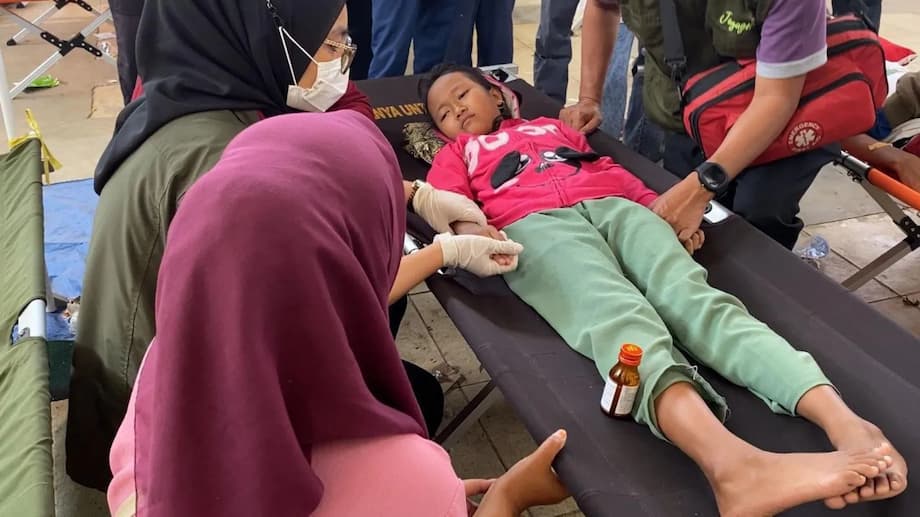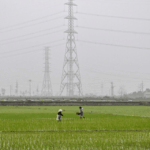A program to fight stunting faces a food safety crisis
Indonesia’s drive to provide free nutritious lunches at schools has entered a difficult phase after a fresh wave of food poisoning cases in West Java sickened more than 1,000 children this week. Local authorities in West Bandung declared a health emergency to speed support for patients and to free up budgets for a rapid response. The outbreaks are the latest in a series of cases linked to the nationwide program, a marquee policy that aims to reach tens of millions of children and mothers by the end of the year.
- A program to fight stunting faces a food safety crisis
- What happened in West Java this week
- Are kitchens and logistics the weak link
- What earlier outbreaks reveal
- Government response and the debate over suspension
- Why the program is so ambitious
- Families and students live with the fallout
- What could make school meals safer now
- The Bottom Line
The scale of the latest illnesses is striking. Officials reported that students in four areas of West Java fell ill between Monday and Wednesday, with hundreds needing treatment for nausea, stomach pain, headaches, vomiting, and shortness of breath. Small hospitals struggled with the sudden influx, and a sports hall was converted into a makeshift treatment center with rows of fold-out beds. The cluster follows two outbreaks last week that affected roughly 800 students in West Java and Central Sulawesi.
Broader counts show how frequently incidents have occurred while the program expands. Watchdog groups say at least 6,000 children have been affected nationwide since January. The National Nutrition Agency has cited 4,711 suspected cases out of roughly one billion portions served, and says investigations and kitchen suspensions are under way. The program, backed by 171 trillion rupiah this year, is set to double its budget next year as the government pushes toward a target of about 83 million recipients. Officials say they do not plan to halt the effort, while non-governmental groups have urged a temporary pause to strengthen oversight and food safety.
What happened in West Java this week
In West Bandung, more than 470 students fell sick on Monday after eating free school lunches, according to local authorities. Two days later, additional outbreaks were reported in West Bandung and the Sukabumi region, lifting the number of affected children to well over 1,000 for the week. Ambulances cycled between schools, hospitals, and the sports hall that served as a treatment hub as parents gathered for news of their children.
Officials declared the situation an extraordinary event so emergency protocols could be used. That step allows a faster flow of funds, staff, and supplies, and it signaled concern that more cases could emerge while investigators traced the source of contamination. Students described dizziness and stomach cramps within hours of lunch, which reportedly included common canteen fare such as chicken, tofu, vegetables, and fruit.
West Java Governor Dedi Mulyadi said the surge in patients overwhelmed smaller facilities and demanded a thorough evaluation of how the free lunch program is being run in the affected districts. He also addressed the emotional toll on children who are now anxious about eating at school.
There is a need to evaluate those running the program and to address the trauma experienced by students, Governor Dedi Mulyadi said.
Local administrators suspended implicated kitchens and coordinated with health offices to collect food samples, interview food handlers, and trace distribution routes. The first priority has been clinical care, followed by testing that can confirm which pathogens were present and how food handling broke down.
Are kitchens and logistics the weak link
Officials investigating recent outbreaks describe a pattern. Some central kitchens were tasked with feeding very large numbers of students and were located far from recipient schools. That combination led teams to start cooking very early, sometimes the night before, then portion and seal meals while still warm. Once sealed, warm food can quickly become a breeding ground for bacteria, especially during long transport in a tropical climate without strict temperature control.
Food safety basics in mass catering
Food safety experts point to time and temperature as the most critical variables. Perishable foods should be kept either cold, generally below 5 degrees Celsius, or hot, generally above 60 degrees Celsius. The window between those temperatures is often called the danger zone because bacteria like Salmonella and certain strains of E coli multiply rapidly there. Rice and other starches can host Bacillus cereus, a spore-forming bacterium that survives cooking and can release toxins if cooked rice is held warm and sealed for long periods. Cross contamination, such as raw poultry juices contacting ready-to-eat salad, can also seed bacteria that later cause illness.
To serve food safely at scale, kitchens need consistent cold storage, accurate thermometers, batch cooking on the same morning of service, insulated containers for transport, and logs that record how long meals spend in transit. Freshly cooked food should be kept hot, or cooled quickly and kept cold if not served immediately. When thousands of lunches are produced off site and travel long distances, any lapse in these steps raises the risk of contamination.
What earlier outbreaks reveal
Events over recent months suggest repeated problems with preparation and handling. In West Java’s Garut region, more than 500 students fell ill after eating chicken and rice prepared by a program kitchen, prompting the local government to switch menus temporarily to simpler items like bread, milk, boiled eggs, and fruit while inspections were carried out. In the Banggai Islands of Central Sulawesi, another mass illness led to a suspension of meal distribution in the area. Tests in an earlier West Java case found Salmonella and E coli contamination. Other reports referenced expired condiments and even a meal that included fried shark, an unusual inclusion that drew scrutiny.
The precise trigger can differ by kitchen and menu, but the common threads are predictable. High-protein items such as chicken, eggs, and tofu require tight temperature control. Fruits and raw vegetables demand careful washing and separation from raw meats. Long transport multiplies the risk. Until each kitchen’s hazard points are mapped and corrected, similar mistakes can recur.
Government response and the debate over suspension
The National Nutrition Agency, which runs the program, says it has suspended kitchens linked to poisoning reports and is auditing procedures. Agency head Dadan Hindayana has acknowledged the breadth of the challenge and has committed to investigations that can inform corrective action.
The agency regrets the food poisoning cases, said Dadan Hindayana. Kitchens with poisoning cases have been suspended while investigations proceed.
Health and education advocacy groups have called for a temporary pause in areas with repeated outbreaks, arguing that oversight remains too thin for a program expanding at this speed. They have pressed for a clearer mechanism to evaluate kitchens after an incident, more independent testing, and menus that rely less on ultra processed products and more on fresh, simple foods that are easier to handle safely. At a parliamentary hearing, analysts warned that the current inspection regime and training do not match the program’s size.
Senior lawmakers say the initiative remains strategic and will continue, even as the government evaluates operations. Officials emphasize that the number of suspected cases is small compared with the number of meals served, but families want stronger guarantees that kitchens are meeting basic safety standards every day.
Why the program is so ambitious
The free lunch effort is designed to support children’s growth, school attendance, and learning, and to cut stunting, a condition linked to chronic undernutrition that affects roughly one in five Indonesian children under five. The plan, unveiled at the start of the year, began with pilot areas and has grown quickly to reach more than 20 million recipients, with a goal of about 83 million recipients by year end.
Its budget stands out worldwide. Indonesia set aside more than 171 trillion rupiah this year, around ten billion US dollars, for the program, with plans to double that in the next year. By comparison, India’s nationwide school meal program operates on a fraction of that annual budget while serving a larger number of students, and Brazil funds a program of similar cost for tens of millions of students. Supporters say Indonesia’s approach could deliver long term health gains and local economic benefits if done safely. Critics warn that the large budget, complex procurement chains, and the use of many third party caterers create opportunities for waste and corruption if oversight is weak.
Families and students live with the fallout
The most vivid images from West Java show a community under strain. In West Bandung, a sports hall was converted into a temporary treatment center, with children on portable beds and others lying on mats while nurses and volunteers moved between them. Outside hospitals, students waited with IV lines as ambulances shuttled new patients in. Parents described a mix of anger and fear as they weighed whether to let their children eat the next school lunch.
Students spoke of sudden cramps and nausea after eating at school, followed by headaches and fatigue at home that night. One middle school student in Central Java described being woken from sleep by waves of pain and a rush to the bathroom.
I woke up at night with sharp pain in my stomach. My head hurt and I kept going to the toilet. The next day I saw many classmates say the same thing, the student said.
Doctors say most patients recover quickly with fluids and rest, but severe cases can lead to dehydration and require hospital care, especially for younger children. Teachers and counselors now face a different challenge, rebuilding confidence in school meals so that students return to normal routines. Some regions have pivoted to simpler menus while audits proceed.
What could make school meals safer now
Food safety specialists, community health groups, and local officials have outlined practical steps that can reduce risk while preserving the program’s goals. Many of these measures are standard for mass catering and focus on basic controls rather than complex technology.
- Cook meals on the same morning of service and avoid overnight preparation, especially for poultry, eggs, and rice.
- Keep hot food above 60 degrees Celsius and cold food below 5 degrees Celsius from kitchen to classroom, with insulated carriers and temperature logs.
- Shorten delivery routes and use more local kitchens so food travels less time and distance.
- Portion food only after it reaches safe holding temperature, and avoid sealing warm meals in tight containers that trap heat and moisture.
- Separate raw and ready-to-eat items at every stage, using color coded tools and dedicated prep areas for raw meats and salads.
- Wash and disinfect produce with clean water and safe sanitizing methods, and train staff to monitor water quality.
- Introduce simple menus during scale up, such as bread, milk, eggs, and fruit, which are easier to handle safely while teams build capacity.
- Require each kitchen to maintain a daily safety checklist, including thermometer checks, cleaning logs, and delivery times.
- Conduct random lab testing of meals and swabs of surfaces, and publish results for transparency.
- Set clear rules for automatic suspension of any kitchen tied to an outbreak, followed by retraining and reinspection before reopening.
Alternatives under discussion
Some civil society groups have proposed giving funds directly to parents so they can prepare meals at home, a suggestion the government has rejected on policy grounds. Others recommend food vouchers or dry rations for short periods in areas where kitchens are being audited, so students still receive nutrition support. Another option raised by education advocates is to shift production from large central kitchens to smaller school based kitchens overseen by parent committees, with scaled purchasing and strict safety training. Lawmakers have also pushed for stronger digital traceability, such as mandatory temperature logging and delivery time stamps, so investigators can quickly pinpoint where a breakdown occurred.
None of these ideas can replace the basics of safe preparation, clean water, and careful transport. They can, however, help reduce risk while a very large program stabilizes and staff gain experience under clear rules.
The Bottom Line
- More than 1,000 children in West Java fell ill from free school lunches this week, prompting a local health emergency in West Bandung.
- The latest cluster follows recent outbreaks in West Java and Central Sulawesi that sickened about 800 students.
- Watchdogs count more than 6,000 affected children nationwide since January, while the National Nutrition Agency cites 4,711 suspected cases out of roughly one billion portions served.
- Authorities suspended implicated kitchens and launched audits, while saying the program will continue.
- Investigators point to early cooking, long transport, and sealing warm food as risk factors that can fuel bacterial growth.
- The program aims to reach about 83 million recipients and has a budget of 171 trillion rupiah this year, which is set to double next year.
- Advocacy groups want a temporary pause in problem areas and stronger oversight, testing, and training across all kitchens.
- Simple safety measures, shorter delivery routes, and transparent inspections can reduce risk as the program scales.




